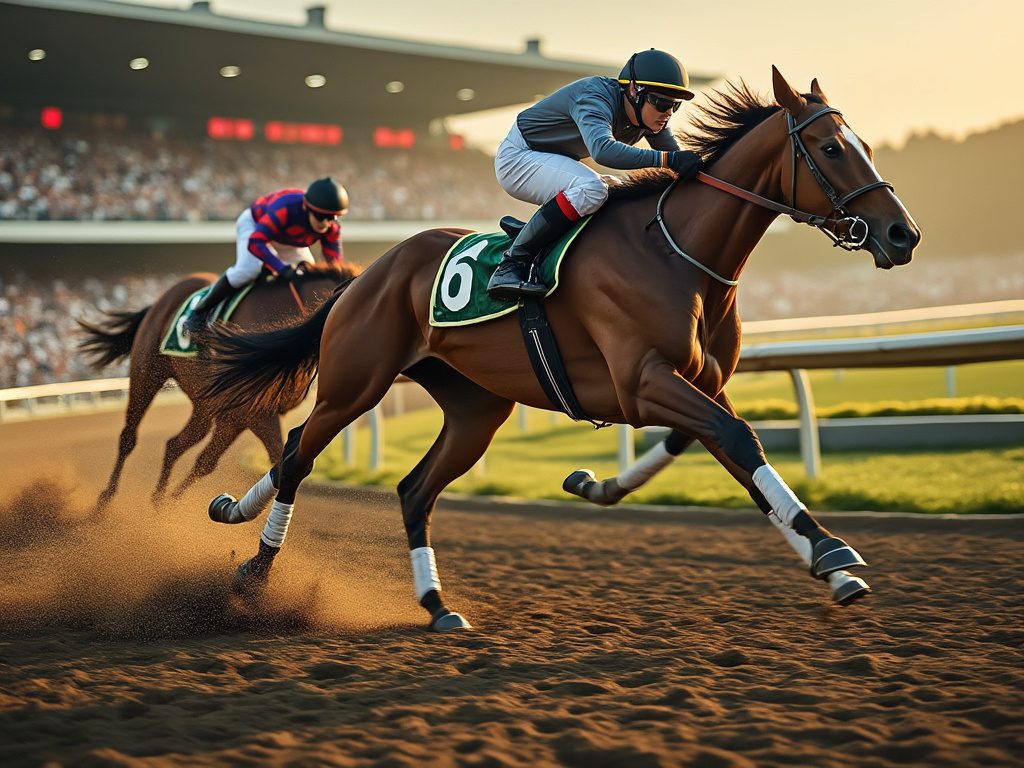

Check out the latest horse racing betting lines at Bet365
Open Account Offer: Bet £10 Get £30 in Free Bets Min Deposit: £5 – Expiry: 30 days – Min Odds: 1/5 (1.20) ← CLICK TO COPY The horse racing community mourns the loss of Macho Uno, a champion racehorse and successful sire, who was euthanized at the age of 26 due to liver complications. Macho Uno, owned by Frank Stronach's Adena Springs operation, had a remarkable career both on the track and as a sire. He was from the third crop of Holy Bull, the 1994 Horse of the Year, and his dam was Primal Force, a Blushing Groom mare also dam to Awesome Again. Macho Uno debuted in 2000 at Saratoga Race Course with a win by 2¾ lengths for trainer Joe Orseno. He went on to win the Grey Breeders' Cup Stakes (G1) at Woodbine by seven lengths and achieved a nose victory over Point Given in the Breeders' Cup Juvenile (G1), earning the title of champion 2-year-old colt of 2000. His 3-year-old campaign saw him win the Pennsylvania Derby (G3) and place in other significant races despite an ankle injury. As a 4-year-old, Macho Uno won the Massachusetts Handicap (G2) and placed third in the Suburban Handicap (G2). He retired with a record of six wins, one second place, and three third places from fourteen starts, earning $1,851,803. His stud career was equally impressive, producing notable progeny like Mucho Macho Man, who won the Breeders' Cup Classic and earned over $5.6 million. Macho Uno's legacy continues through his offspring, who have collectively earned more than $67 million. In an exciting development, Baltimore Ravens' quarterback Lamar Jackson has partnered with the National Thoroughbred League (NTL) to modernize horse racing by introducing a team-based element. The NTL, co-founded by Randall Lane, began last season with six clubs and has expanded to ten teams after a successful inaugural year. The second season will feature events in Nashville, Philadelphia, and Phoenix, with over $3 million in purses awarded across three events. Jackson's involvement is seen as critical for connecting the new Maryland Colts team with the community. The NTL aims to revolutionize thoroughbred racing by making it easier to follow through team continuity, similar to football, baseball, and basketball. This initiative also emphasizes community engagement, with Jackson playing a key role in amplifying Baltimore’s rich horse racing culture and creating local jobs. Check out the latest horse racing betting lines at Bet365
Director Luis Ortega‘s new film, “Kill the Jockey,” set in Argentina's horse-racing community, has garnered attention for its unique portrayal of the sport. The film, which plays in the Venice competition, features exotic jockeys and horse owners and centers around the character Remo Manfredini, played by Nahuel Pérez Biscayart. Remo is a psychologically damaged character who abuses drugs and alcohol but retains a sense of self-possession and panache. Ortega's film has a satirical tone, portraying Argentine society as corrupt and violent, and explores themes of birth and death linked together. The visual style, crafted by Finnish cinematographer Timo Salminen, gives the film a unique look distinct from other Argentine films. Ortega's personal experiences and impending fatherhood influenced the film's themes and tone, adding depth to its narrative. Racing analyst J. Keeler Johnson has highlighted several promising horses in his biweekly series. At Saratoga, Virgin Colada finished second in the P. G. Johnson race, showing impressive speed in the final quarter-mile. Federal Judge returned from a 13-month layoff to finish second in a $62,500 allowance optional claimer, remaining competitive at the same class level for an upcoming sprint. At Del Mar, Nothing Like You has shown significant talent but struggles with consistency. She won the Starlet (G2) and Santa Anita Oaks (G2) impressively but needs to deliver a peak performance in the Torrey Pines (G3). War Like Goddess seeks a second Flower Bowl triumph at Saratoga, having recently won the Robert G. Dick Memorial (G3) under Hall of Fame trainer Bill Mott. Open Account Offer: Bet £10 Get £30 in Free Bets Min Deposit: £5 – Expiry: 30 days – Min Odds: 1/5 (1.20) ← CLICK TO COPY Former chief steward of the Hong Kong Jockey Club, Jamie Stier, emphasizes the importance of using science to address horse welfare, which he considers the biggest global challenge in the racing industry. Speaking at the Asian Racing Conference in Sapporo, Stier highlighted the need for significant improvements in equine safety to enhance public perception of horse racing. Stier outlined four areas where racing can use science to prevent fractures and sudden deaths, advocating for targeted investment and international research collaboration. He called for dedicated funding to enable researchers and scientists to assist regulators in developing new systems, protocols, policies, and training methods that reduce injury risks. Stier believes that effective collaboration with researchers can lead to positive changes in racing and enhance public perception of the sport. The Pacific Classic has become a marquee event in horse racing, thanks in part to the legacy of Best Pal. Best Pal's performances helped put the Pacific Classic on the national horse racing map, drawing attention to the event and elevating its status. The race continues to attract top competitors and remains a highlight of the racing calendar. The horse racing industry is constantly evolving, with new developments and challenges shaping its future. From the loss of champions like Macho Uno to innovative partnerships and scientific advancements, the sport continues to captivate and inspire. As stakeholders work together to address challenges and embrace new opportunities, the future of horse racing looks promising. Enthusiasts and participants alike can look forward to more thrilling races, groundbreaking initiatives, and a continued commitment to the welfare of the horses that make this sport so special. The world of horse racing is always bustling with activity, from thrilling races to significant industry changes. Recently, several noteworthy events and updates have captured the attention of enthusiasts and stakeholders alike. This article delves into the latest horse racing news, providing a comprehensive overview of key happenings and their implications for the sport.
18+ New Customers only. Bet £10 and get £30 in Free Bets when you join bet365. Sign up, deposit between £5 and £10 to your account and bet365 will give you five times that value in Free Bets when you place qualifying bets to the same value settle. Free Bets are paid as Bet Credits. Min odds/bet and payment method exclusions apply. Returns exclude Bet Credits stake. The bonus code BET247 can be used during registration but does not change the offer amount in any way. T&Cs, time limits & exclusions apply. Registration Required.
Champion Macho Uno Euthanized at 26
Lamar Jackson Partners with National Thoroughbred League
Film “Kill the Jockey” Explores the World of Horse Racing
Horses to Watch: Major Races at Saratoga and Del Mar
18+ New Customers only. Bet £10 and get £30 in Free Bets when you join bet365. Sign up, deposit between £5 and £10 to your account and bet365 will give you five times that value in Free Bets when you place qualifying bets to the same value settle. Free Bets are paid as Bet Credits. Min odds/bet and payment method exclusions apply. Returns exclude Bet Credits stake. The bonus code BET247 can be used during registration but does not change the offer amount in any way. T&Cs, time limits & exclusions apply. Registration Required.
Using Science to Tackle Horse Racing's Biggest Challenge
Best Pal's Legacy in the Pacific Classic
Conclusion: The Future of Horse Racing
#AD Bonus Referrer Code is an affiliate of the brands we promote throughout this site. While we strive to maintain accuracy throughout our content, we do receive compensation for this promotion.
© 2025 BonusReferrerCode.com – All Rights Reserved
Worried about your gambling? When the fun stops – STOP!